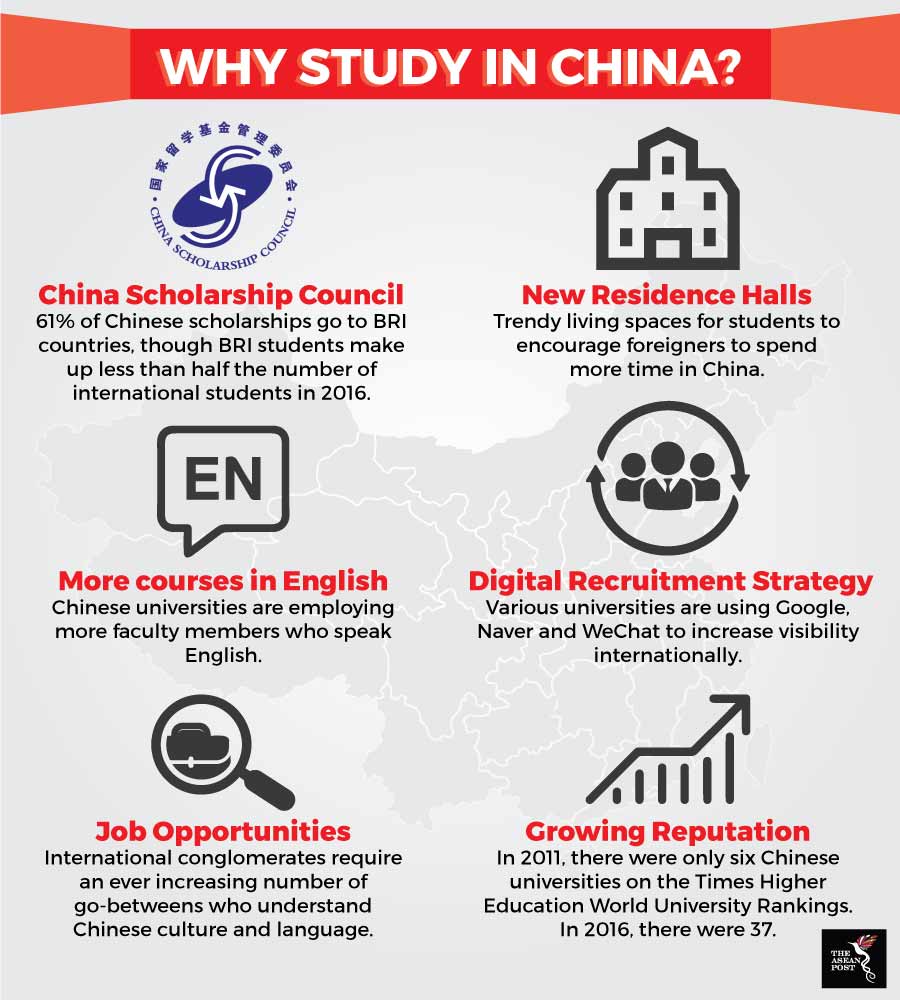Even with sketchy financial information, research academics agree that China’s island building in the Spratly archipelago is a multi-billion-dollar undertaking. Some estimates note that building up Fiery Cross island alone, with its three-kilometre runway and military facilities including missile and radar installations, have cost around US$11 billion. But this is the pointed-end of the spear, and it is only one part of China’s global expansion plans.
What about their soft power initiatives? Pairing with China’s aggressive yin, is the congenial yang of university scholarships for ASEAN’s brightest young minds. Not to mention the export of Chinese tertiary-education brands like Xiamen University Malaysia, Suzhou University in Lao PDR and research collaborations between Singapore University of Technology and Design and Zhejiang University of Finance and Economics or the Xi’an Jiaotong University Thai Princess Sirindhorn Special Scholarship.
According to the China University and College Admission System (CUCAS) – an online information and application portal with links to the country’s education ministry – an estimated 80,000 students from Southeast Asia opted for a Chinese education in 2016. This represented a 15 percent increase from 2014. In fact, students from ASEAN nations now form the biggest group of foreign students studying in China’s institutions of higher learning.
 Sources: Various
Sources: Various
While these are the means, the ends are the fruition of China’s grandiose trade ambitions, chiefly, the Belt and Road Initiative (BRI). At the 2017 BRI Forum for International Cooperation in Beijing, Chinese President Xi Jinping outlined a new form of globalisation, played out in the domains of infrastructure, business, security and education. Considering the current climate of global rebalancing, and the unwillingness of the United States (US) to show leadership, China is champing at the bit to fill this power vacuum.
According to Zhang Baohui, a professor and director at the Centre for Asian Pacific Studies at Lingnan University in Hong Kong, “Exporting education is a way to promote China’s soft power. [The BRI] is not just an economic initiative. It reflects China’s quest for broader influence in the world.”
“The quality of Chinese universities has improved in the last decade. So poorer countries along the Belt and Road should welcome them to establish a presence and train local students,” he added.
What is crucial, is that ASEAN countries view soft power in a continuous spectrum rather than a dichotomous one. The objective is to build authority without force, and this enables states to achieve their goals more easily in a complex international system. Chinese officials and academics expressed the importance of China’s culture in the 1990’s and in the early 2000’s, but soft power was explicitly referenced in national government policy for the first time at the 17th National Congress of the Chinese Communist Party in 2007. Former Chinese President Hu Jintao said, “The great rejuvenation of the Chinese nation will definitely be accompanied by the thriving of Chinese culture.”
This formulation of tying culture to China’s place on the world stage, echoes other core principles such as China’s “peaceful rise” and its vision of a “harmonious society”. These ideas were intended to counter narratives from the West that China’s emergence was a threat to the existing international order. Still, disregarding the Spratlys, this hasn’t happened because China’s value system and cultural traditions have yet to be fully understood by the international community.
Even as global interest in China grows, its creative and cultural contributions have yet to capture the attention and imagination of wider global audiences. These have proved to be major roadblocks in the country’s hopes of becoming a global soft power.
With regard to China’s ambitions in education, there’s been a severe backlash. In 2013, the Canadian Association of University Teachers called on all universities hosting Confucius Institutes to stop doing so. The Confucius Institute has been a government program that provides foreign universities with generous cash grants to set up Chinese language and cultural courses. There are 512 university campuses hosting the program across 130 countries. Similarly, the American Association of University Professors followed suit, saying Confucius Institutes “function as an arm of the Chinese state” and “advance a state agenda in the recruitment and control of academic staff”.
Some say China’s soft power push will only last as long as its cash reserves do. According to experts, China does not possess enough influence to be accepted worldwide because culturally, the Chinese global image is not good. Secondly, China cannot set global trends despite public diplomacy efforts to improve the Chinese image.
But in an ASEAN context where Chinese direct investment is calculably and objectively raising living standards, go-betweens who understand the language and business culture will be invaluable to the many conglomerates who want to expand beyond just island fortresses.
This article was first published by The ASEAN Post on 13 August 2018 and has been updated to reflect the latest data.
Related articles:
